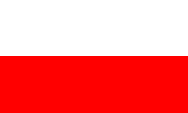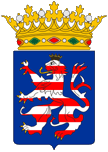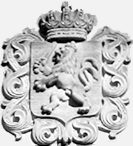• Flag
• Meaning/Origin of the Flag
• Coat of Arms
• Meaning/Origin of the Coat of Arms
• Map
• Numbers and Facts
• History
• The states of Hesse
• Origin of the Country's Name

1596–1866,
flag of the country (colours),
Source, by: Wikipedia (D)





The flags of the Hessian Landgraviates were always red-and white or white-red bicolours. The colours go back to the lion in the coat of arms of the Landgraviate of Thuringia in the 12th and 13th centuries, from which the country finally emerged, which was horizontally striped in white and red. The line of Hesse-Homburg arised in 1596 by splitting off from the line of Hesse-Darmstadt. Only here was changed - in contrast to the other Hessian counties - the order of the colors in the bicolour, namely reversed to white and red.
Source, by: Flags of the World,
Wikipedia (D)


lesser coat of arms of the Landgraviate of Hesse-Homburg

middle coat of arms of the Landgraviate of Hesse-Homburg,
Source, by: Wikipedia (D)

The coats of arms of the Hessian Landgraviates showed a blue shield with a white and red striped lion. This golden armed, golden crowned, lion rampante is the Lion of the Ludowingers, an originally Thuringian symbol, which goes back to the end of the 12th century, to the Landgrave Hermann I. of the dynasty of the Ludowingers.
The middle coat of arms of Hesse-Homburg shows seven fields: 1. Principality of Hersfeld, 2. County of Ziegenhain, 3. County of Katzenelnbogen (above), County of Nidda (below), 4. the heart shield, Landgraviate of Hesse, 5. County of Diez (above), County of Rieneck (below), 6. County of Schaumburg, 7. Principality of Isenburg. The shield here is crowned by a count's crown. However, this is uncertain. The monarch was indeed Landgrave (a Count), but in practice were used frequently higher rank crowns.
Originally, the lion was depicted with eight white and red striped bars, in the 15th Century, there arised nine stripes. There exist depictions of the lion with one or two tails. This is without heraldic significance.

Source:
Historischer Verein Ingelheim
After the extinction of the male line of Landgraves – the House of Ludowinger – in 1247, there was a succession war between the Margraves of Meissen (House Wettin) and the Duchy of Brabant (Sophie, Duchess of Brabant, House of Ludowinger). The war ended in 1264 and much parts in the east of the Landgraviate of Thuringia came to the House of Wettin. Those became later the Wettin-Ernestine duchies. The West came as Landgraviate of Hesse to the son of Sophie of Brabant. The Thuringian coat of arms (white-red striped lion on blue) was adopted by both dynasties. The as a result of the Hessian division of 1567 (and even later) arising lines of the Landgraves of Hesse, all continued the blue shield with the white-red striped with lion.
Source, by: Reservistenverband Kreisgruppe Südhessen,
Wikipedia (D),
Flags of the World


Source: Hand-Atlas für die Geschichte des Mittelalters und die neueren Zeit, 1880
The historical map shows the Landgraviate of Hesse-Homburg between the years 1815 and 1866, within a magenta coloured border. It consists of two separately located territories, the districts of Meisenheim and Homburg.

Area: 85 square miles (1865)
Inhabitants: 27.500 (1865)
Capital: Homburg
Currency to 1866: 1 Taler = 30 Groschen = 360 Pfennige, from 1866 Prussian Currency
Source: HGIS - Historisches Deutschland,
Der Michel

1145–1254 · Landgraviate of Thuringia
1254–1264 · heritage succession war, separation of Hessen from Thuringia
1264 · Landgraviate of Hesse
1567 · division of the ruling family in four different lines (1. Landgraviate of Hesse-Kassel, 2. Landgraviate of Hesse-Darmstadt, 3. Landgraviate of Hesse-Marburg [to 1604], 4. Landgraviate of Hesse-Rheinfels [to 1583])
1596 · formation of the Landgraviate of Hesse-Homburg, under the suzerainty of Hesse-Darmstadt
1671–1680 · Hesse-Homburg is a part of Hesse-Darmstadt
1680 · re-establish of Hesse-Homburg under the suzerainty of Hesse-Darmstadt
1708 · Hesse-Homburg is independent
1806 · Hesse-Homburg comes again under the supremacy of Hesse-Darmstadt
1814–1815 · Vienna Congress, reorganization of Europe after the Napoleonic era, Hesse-Homburg becomes in 1815 officially the Landgraviate of Hesse (the Landgrave of Hesse-Kassel became in 1803 Elector)
24th of March in 1866 · the Landgraviate of Hesse(-Homburg) becomes annexed to Hesse-Darmstadt and expires
1866 · Fratricidal War of Prussia against Austria, Hesse-Darmstadt and Hesse-Kassel are on the side of Austria and defeat, Hesse-Kassel and the former Hesse-Homburg become occupied by Prussian troops in August 1866, abolished in October 1866 and annexed to the Prussian Province of Hesse-Nassau
1945 · the Allies establish the Country of Greater Hesse (the present State of Hesse), by unification of Hesse-Darmstadt and Hesse-Nassau under loss of Rhine-Hesse, the former Hesse-Homburg becomes annected to the newly founded State of Rhineland-Palatinate in 1947
Source: Atlas zur Geschichte,
World Statesmen,
HGIS - Historisches Deutschland

1.) from 1567 Landgraviate of Hesse-Kassel, since 1803 Electorate of Hesse, since 1866 to the Prussian Province of Hesse-Nassau
2.) from 1567 Landgraviate of Hesse-Darmstadt, 1803–1918 Grand Duchy of Hesse, 1918–1945 Federal Country of Hesse
3.) from 1596 Landgraviate of Hesse-Homburg, since 1866 to the Prussian
Province of Hesse-Nassau
4.) 1567–1604 Landgraviate of Hesse-Marburg
5.) 1567–1583 Landgraviate of Hesse-Rheinfels
6.) 1648–1681 Landgraviate of Hesse-Bingenheim
Source, by: Wikipedia (D)

The name "Hesse" is based on a Germanic tribe with the same name who lived here during the time of the Romans. This tribes was called by the Romans "Chatti". The name "Homburg" is derived from the word "Hohenburg" ("High Castle").
Source: Handbuch der geographischen Namen







![]()








![]()